|
Aircraft Wrecks in the
Mountains and Deserts of the American West
F7F-3P
1/28/47
Video by
John Walker
On January 28, 1947 USMC Capt. Wilbur J. “Gus” Thomas and M/Sgt Morgan W.
Hopwood departed North Island NAS en route to El Toro MCAS, flying Grumman
F7F-3P Bu No 80427. A powerful winter storm was pounding Southern California
with moderate to heavy rain and gusty winds. As Captain Thomas approached El
Toro he had successfully lined up for a landing, but he was about 200’ low and
collided with a mountain ridge SE of Santiago Peak. There was no post impact
fire and the F7F-3P lay broken into three large pieces.
Avid Orange County hunter and hiker Bob Pargee visited the crash site in the
early 1950’s and described the wreck as partly intact, the overall midnight blue
paint scheme still looking fresh. Yellow X’s had been painted on the wings and
tail marking the F7F-3P wreckage as “known and not be reported”. Sometime in
the mid to late 1950’s most of the wreckage was removed for salvage value by a
civilian, leaving only 2-3% at the site today. The last vestiges of a brush
fire that burned over the crash site several years ago has given way to new
growth chaparral that now covers the entire site.
On May 27, 2010 the Project Remembrance Team that included G. Pat Macha, Tom
Maloney, Dave Mihalik, John Walker, and Jay Gentile hiked to the crash site to
pay our respects to the memories of Capt. Thomas age 26 and MSgt Hopwood age 27.
We then worked to determine the disposition and quantity of the remaining
wreckage.
Capt. Gus Thomas was highly decorated having earned the Navy Cross and the
Distinguished Flying Cross for destroying 18.5, Japanese aircraft while serving
with VMF-213 in the South Pacific Theater of Operations. Capt. Thomas was
assigned to VMP-254 a photo reconnaissance squadron assigned to El Toro MAS at
the time of his death.
Findings: Capt. Thomas was lined up for the approach to El Toro, but he was
several hundred feet too low. The crash site is not on the SE flank of Santiago
Peak as reported in all official USN documents, but near another peak more than
six miles to the southeast of “Old Saddleback”. Weather was a factor in this
accident. 1-2% of Bu No 80427 remains at 4,400’ MSL in rugged chaparral covered
terrain. Ink stamped prefix numbers confirmed the wreckage to be that of a
Grumman F7F aircraft.
Site visitations: March 2009 and May 2010.
Special thanks: Bob Pargee, Dan McAnarney, and Craig Fuller of AAIR.
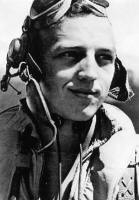
Wilbur J. "Gus" Thomas 7th ranked USMC Ace of
WWII credited with 18.5 kills. (USMC Official)
|
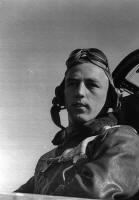
USMC Lt. W. J. "Gus" Thomas aboard his Vought
F4U-1D "Corsair" assigned to VMF-213. (USMC Offical) |
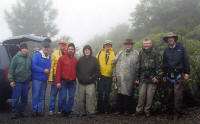
When you're hunting for a Tigercat it takes teamwork. From left
to right Pat
J. Macha, G. Pat Macha, Mark Eades, Dan McAnarney, Korean War Vet Lloyd
Roberts, Tom Maloney, Bob Pargee, Chris LeFave, and Keith Phillips.
|

The F7F-3P model with map, accident report, and data card. |
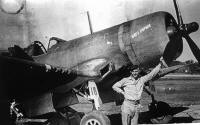
USMC South Pacific USMC Ace Captain Wilbur J. "Gus" Thomas and his Vought
F4U-1 "Gus's Gopher" of VMF-213 on Guadalcanal. Photo courtesy Dan McAnarney via USN
Official. |
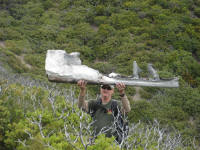
As our team surveyed the F7F-3P crash site Tom
Maloney discovered a control surface showing damage from a brush fire.
|
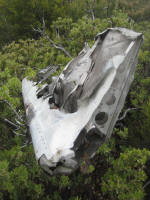
Another view of the fire damaged control surface.
|
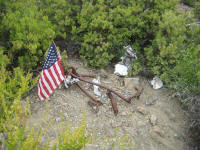
Our team always displays "Old Glory" while on
site out of respect to the crewmen. Parts of the Grumman F7F-3P lie
scattered across a manzanita and buckthorne covered slope just below a
ridgeline that USMC Capt. Gus Thomas almost cleared on 1/28/47.
|

Another discovery made by Tom Maloney was this
near perfect casting and bearing assembly. |
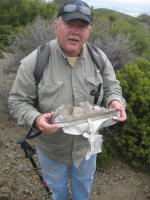
Team member Dave Mihalik holds a piece of F7F-3P
skin.
|
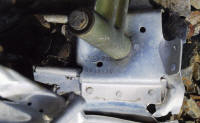
Grumman is known for the use of ink stamped
prefix numbers as seen in this photo. |
|
|